- Popular Types of Bermuda Grass Explained - April 21, 2022
- When to Mow New Grass - April 18, 2022
- Best Troy Bilt Push Mower: How to Find The Right One - April 25, 2021
Are you planning to do overseeding on your lawn after doing it only to be disappointed by the results? There is a high probability that the activity failed due to an inaccurate process.
Gardeners think that if they aerate before they overseed, they would critically increase their lawn grass density. Ask an expert, and they will tell you that aerating your garden is key in making sure soil is loose before you overseed. It is due to such reasons that people aerate to increase the breathability of the seeds.
However, one of the issues with aerated soil is that the lawn can look shabby for a while, making it almost impossible for the gardener to move around while performing other duties.
The worst part is that the aerated wet soil may cause the shoe stain, choking the newly planted grass. I don’t doubt that aeration is good for any plant, especially grass for faster and healthy growth but not all grasses need aeration before overseeding.
Benefits Of Overseeding
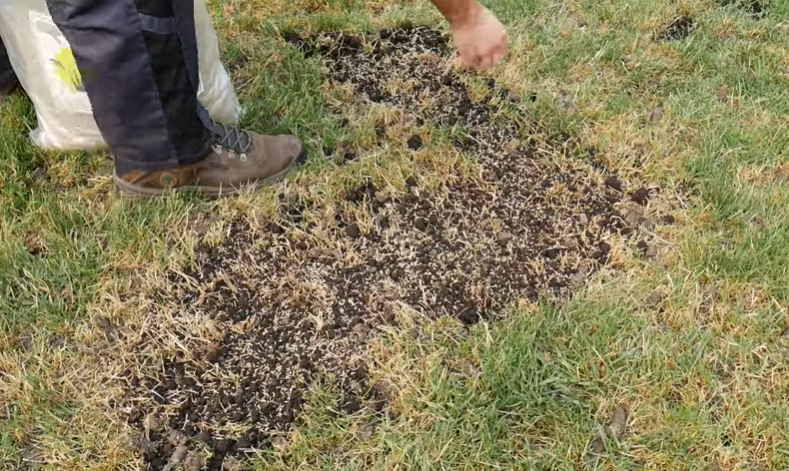
Heavy traffic, including vehicles and a human being, can subject your lawn to a toll, making it look unpleasant even though it looked nice the moments before.
Not sure if you need an overseeder or slice seeder? Check out their main differences in our full comparison here.
If you realize the traffic has done justice on your lawn, it is good to overseed as the results will benefit you. Among the benefits of overseeding include:
Significantly Reduces Soil Erosion
Grass grows with compacted roots that tightly hold up soil and, in return, retain water in the right place exactly where you want them to be.
This ensures no soil is lost while preventing runoff and improving your lawn’s overall health since it can hold up water and nutrients needed for the growth.
Improves Appearance
If you are going to dedicate and devote your time to work on your lawn, the results will be forthcoming. Make time to bald the patches and the damaged parts by people, vehicles, pets, and plant fresh seeds.
Roughing up the spots that need attention using a rake, casting your seeds, and keeping your soil’s moisture will indeed improve the appearance of your lawn. Use your sprinkler for even watering of the seeds until they germinate. Not only will that lawn look appealing, but it also feels good underfoot.
Minimizes Risk Associated With Pests And Diseases
A good and healthy lawn would be ideal for diseases and pests prevention. If you have a lawn and the lawn’s better history is all about the attack by pests and diseases, you don’t need to get different chemicals that may drain your bank account. You can as well have varieties of different grasses.
You can have the grass according to your climate and most probably go for the ones requiring the least amount of water and highly disease-resistant ones. The advantage of a mix of grass seeds is that they attract and support pollinators and other beneficial insects.
Increases Thickness
What are you after as far as your lawn is concerned? If a thick carpet is all you want, then you can achieve that through overseeding.
A good timing overseeding with the right amount of water will do magic in transforming your thin lawn to a thick one, plus give it that appealing green color. Both water and overseeding will make the grass stick together, forming a verdant surface that becomes more durable, withstands traffic, and also holds up the natural weathering and other environmental stress.
Save On Chemicals
A well maintained and kept lawn means no diseases and pests. This makes it unnecessary and eliminates the need to use chemicals to counter pests and diseases.
When you manage to keep a sturdy and robust lawn without investing too much in chemicals and fertilizers, you save a lot in the long run and only meet other usual bills like water and what have you.
Steps Involved In Overseeding A Lawn Without Aerating
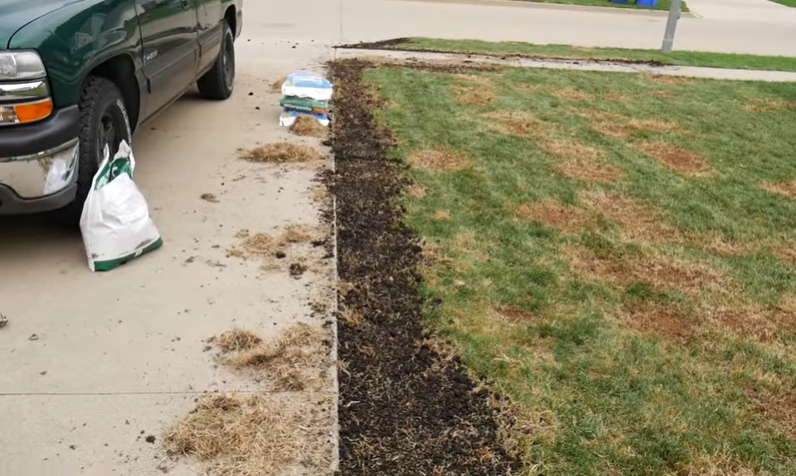
Overseeding is deemed as the most effective way to grow your lawn thick and full. Not only will overseeding make your lawn thick and full, but it also offers a perfect solution to the lawn with patches caused by different factors, including human traffic and pests.
However, not every other person outside knows how to overseed without aerating. If you might need any clarification, follow the below steps.
1. Mower Your Lawn For Height Less Than Two Inches
Mowing your lawn should be the first step in your journey to overseed without aerating, and you should cut the grass lower than the usual cut. In other terms, the rule of the game here is to cut the mower lower than two inches.
Advantages of mowing before overseeding prevent the growth of weeds and competition from the established grass and the sunlight to reach the soil to provide the much essential seedlings’ growth.
2. Rake To Remove Thatch And Loosen The Soil
If you try to oversee the soil with a thick layer of thatch, you can be assured of poor germination. This is why it is recommendable to power the rake instead of aerating before you overseed. Through power raking, you will remove the tight layer of the roots, stems, and rhizomes that make up the thatch layer.
The dethatching exposes the soils to the sunlight providing warmth to the seedlings to provide excellent germination.
3. Spread The Grass Seeds
Spreading your grass seeds comes as the third step and depends on the spreading rate with the different grass you are overseeding. You can get a drop spreader or broadcast spreader to help you in overseeding with great coverage. However, the number of seeds you want to overseed will depend on how thick you want your lawn to be.
We recommend spreading more seeds to establish a new lawn if you look forward to having a thicker lawn faster. Otherwise, you can follow the usual overseeding guideline for optimum results. Ensure there is good contact between the soils and the seeds. For the best results, spread the seeds in the opposite direction.
4. Rake the Over The Overseeded Space Gently
Once you are done overseeding, get your rake and gently rake over the soil, be certain that the seeds have rested well in the soil. This will ensure there are no seeds on the soil that may be eaten by the birds and also assures you that they will not be washed immediately when you start watering.
Be keen not to overdo this step since you have found yourself overcrowding the seeds in one place, leaving the rest of the space with no seeds. It would be better if you can rake in all directions rather than doing it in one direction.
5. Fertilize The Overseeded Area
Like any other plant, grass also needs to be fertilized for health and good growth and germination. It is ideal for fertilizing the overseeded lawn with fertilizer to reach high phosphorus levels as it helps in roots development when grass germinates.
We advise people not to use the weed and the fertilizer when planting grass seeds since the pre-emergent herbicides found in them can interfere with the new grass seeds’ normal germination process or development.
In most cases where you are overseeding without aerating, you will be required to apply 1 lb of nitrogen per 1000 sq; ft. before using any fertilizer. Ensure you have read all the instructions and do as they direct you.
6. Water Your Lawn
Watering your lawn comes as the last step, but it does make it any less important. In fact, this is, most importantly, more than some previous steps. Do the watering lightly, making sure you don’t cause any soil erosion and eroding seeds from the overseeded area.
Ensure soil is moist and not too wet, and keep it that, especially if you did lay down some compost before overseeding. One reason why constant watering would be important in some compost is that some are too hot for the newly germinated plants and may hurt them.
Watering should be done at least twice a day to keep the moisture levels to enhance proper germination. We recommend frequently watering with less water in a day rather than watering one time with a lot of water, which can wash away the grass seeds.
You are encouraged to use sprinklers and avoid other things like a puddle, which can damage the overseeded areas. It may take overseeded seeds up to 21 days before they germinate. During this period, you must maintain constant watering to guarantee a high germination rate from the grass.
When Is The Best Time To Oversee Your Lawn?
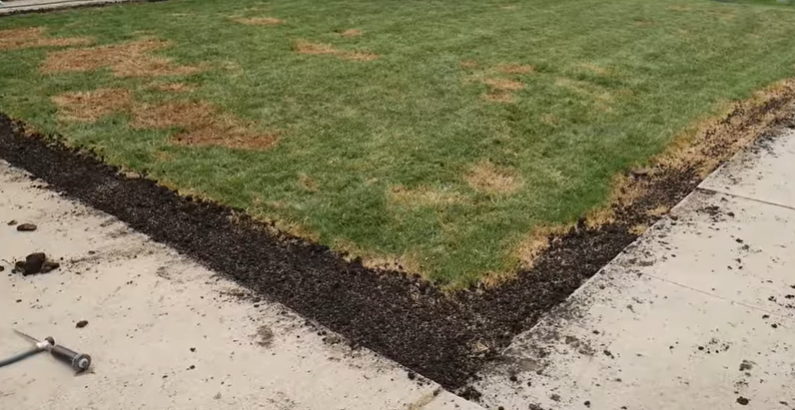
More than often, we get people asking the appropriate and the right time to overseed. Well, that is a good question because long timing would mean ineffective or poor overseeding.
The best time to overseed remains to be early fall. The people living in the northern part of America can get overseed from August 15th to September 15th.
This is when temperatures are still warm enough to encourage growth during the day, and cooler nights keep the new seedlings off from the heat. Remember the key factors for seeds to germinate: soil, ideal temperature will result in quick seed germination.
How To Maintain Your Lawn After Overseeding
It will take your seeds a range of seven to twenty-one days for them to germinate, and you will be required to ensure soil is constantly moist to trigger germination. If you practice irrigation, it would be easy for you as you only need to set a sprinkler or even water by hand.
Within the range of seven to twenty-one days, you will see seedlings sprouting. Don’t stop watering them as they constantly need water all through the first fifty-six days of existence because they still have no mature root system, and they might dry up quickly.
If you constantly fertilize your lawn, there would be no need to fertilize your newly germinated seedlings. There is still enough fertilizer in the soil for them to get them growing. When overseeding, applying fertilizer may bring about unnecessary competition from the established grass and hard for the seedlings to get established.
Overseeding Mistakes You Should Avoid
According to a lawn care expert, there are common mistakes that gardeners make when we talk of overseeding. To ensure you don’t do them, we prepared a short guide for you. They are as follows.
1. Failure To Protect Your Lawn
Your newly overseeded lawn should not be subjected to traffic even if you do watering daily. You should avoid stepping on them as physical stress will damage the seedling and significantly minimizes their chance of germinating and turn out to be healthy turn blades. Ensure children, pets, and any other thing that may damage seedlings away from the lawn as much as possible.
2. Incorrect Lawn Watering
The newly overseeded seedling must be watered daily and twice a day. That is a must, and there is nothing to argue about it. If you are using irrigation, it is up to you to make sure you do so without causing any harm to the seedlings. When it comes to watering, ensure that the quartet of the surface soil is moist throughout. Before you embark on the normal watering routine, ensure the new grass’s blades reach the recommended heights.
3. Mowing Too Soon Or Too Late
When it comes to mowing our newly overseed lawn, you need to be vigilant as the whole process is tricky. You may end up mowing too early or too late.
We recommend mowing the lawn only after it has reached the recommended height. Additionally, you can wait until the seedlings develop sturdy roots and blades and avoid the lawn for two to four weeks to ensure no traffic that may stress the seedlings.
4. Using Chemicals To Fighting Against Weeds
Weeds are fond of showing up immediately after overseeding, and as it is the norm with many lawnmowers and gardeners, they harm themselves with a chemical to get rid of the weeds.
What many of them never know is that by invading your lawn with all sorts of chemicals with the sole aim of eliminating weeds, they end up hurting and harming the blades and the roots of the seedlings.
We recommend leaving your weed for a while until you mow your lawn four to five rounds. After there, you can call the expert to come and implement professional weed treatment without hurting the newly grown lawn.
Best Of The Materials And Tools You Need
1. Green Works G-MAX 40V 16 Inches Cordless Lawnmower
Are you looking for a quiet and hassle-free lawn mower? Green works G-MAX 40V 16 inches cordless lawn mower makes the right lawnmower for you.
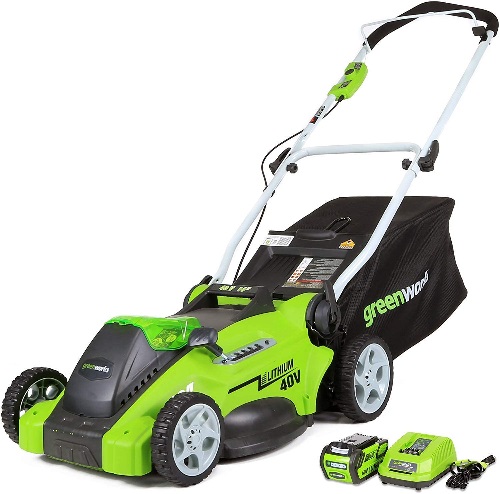
Whether it is the noise, the fumes, or the hassles of maintaining the gas power tools, you don’t have to look any further. This mower makes it easier for you to transits to direct current operated or rather battery operational tools. It is easy to operate and requires low maintenance. It also does a great job in both small and medium-sized back yards.
It is designed with a 16-inch cutting edge and a 2 in 1 feature combined with the five-position cutting height, making it perfect for people looking to trim down their carbon footprint.
There are no pulling cords, which ensure you will not be messing up with the gas, and no maintenance from season to season. With the power button’s simple press, you get ready to commence your cleaning from neglect.
You don’t have to worry about the storage. The lawnmower is designed with handles that fold easily after you are done cleaning, enabling easier and compact storage and easy transportation with up to 45 minutes of run time, giving you all the reasons to go green.
If you realize pushing the lawnmower is hard, you can open the grass clippings from the grass catcher bag and empty it for easier pushing.
Features
- Designed with single level 5 position height adjustment to offer different cutting heights
- Six-inch front wheel and seven inch rear wheel for easier maneuver
- 2 in 1 feature offering to offer to the rear and mulching capability for multiple uses
- 16-inch cutting deck for small and medium maneuverability
Pros
- Ability to mulch in addition to rear bag catching
- No cost incurred when it comes to gas, and maintenance cost is low.
- Its power increases as you come across heavy patches.
- It is relatively quiet.
- Goes up to 60 minutes of constant mowing without breaking down due to power
- Its battery is compatible with up to 25 other tools under the same brand.
Cons
- Lacks the side discharge that lowers its flexibility
- It may last for less than 60 minutes if your grass is thicker and longer than usual.
- Relatively highly priced
- It is only 16 inches, and it may require additional time to get the grass cut.
2. ERGIE SYSTEMS ERG-LFRK24 RAKE
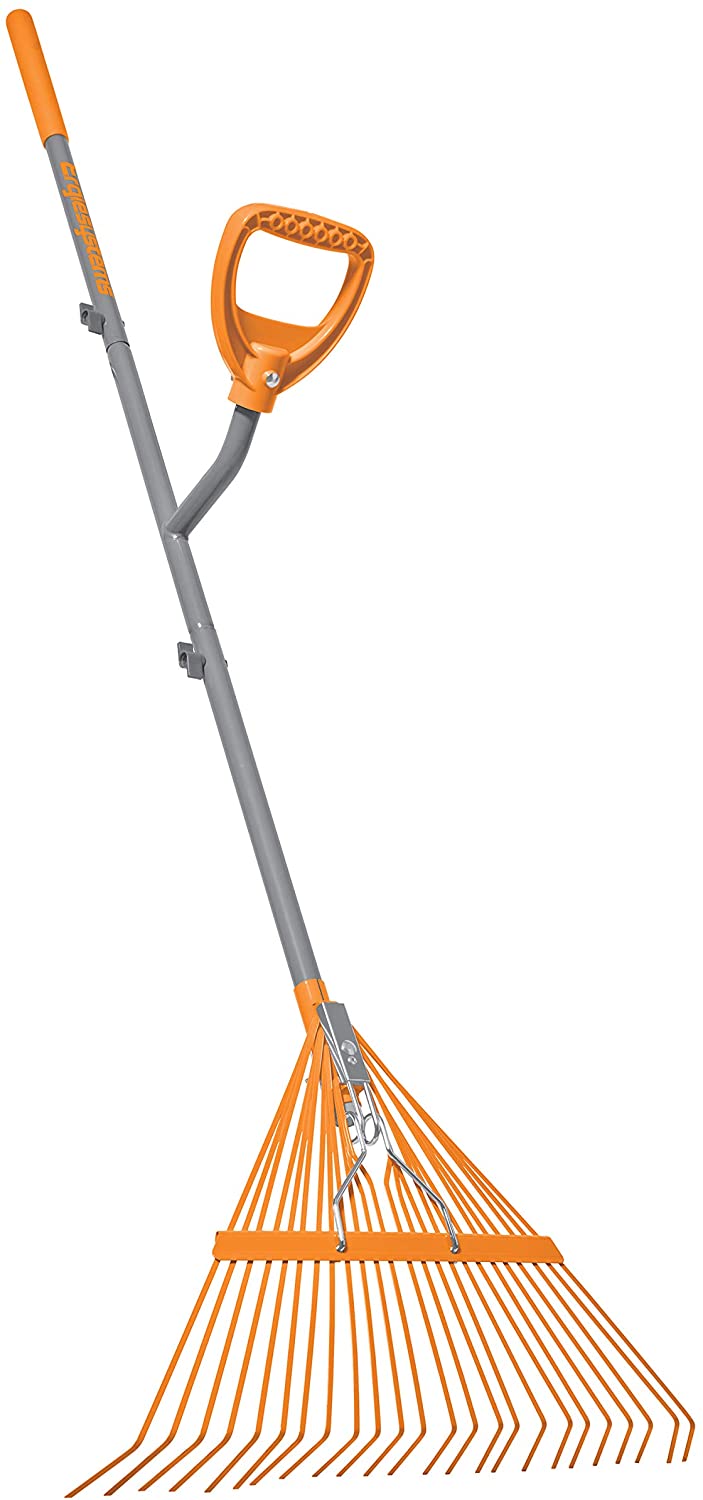
You can always make your work easier with an innovative rake. It is made with several features that are why it made it to our lists.
The features include the handle that connects to the steel shaft to reduce the strain on your back and prolong the working duration.
It is made with 24 3 inch teeth to ensure effective and efficient collection of debris.
Features
- Added handle for leverage helping in reducing strain on your body
- Large D-grip for external control
- 24 3 inch rake teeth that collect debris effectively
- Comes with a two-year warranty from the date of purchase
- It comes in three-piece smart lock assembly making storage easier.
Pros
- Innovative handle curved design of tines
- Efficient and effective performance
- Robust and sturdy construction
Cons
- It is relatively heavy.
3. Scotts 76121 Turf Spreader
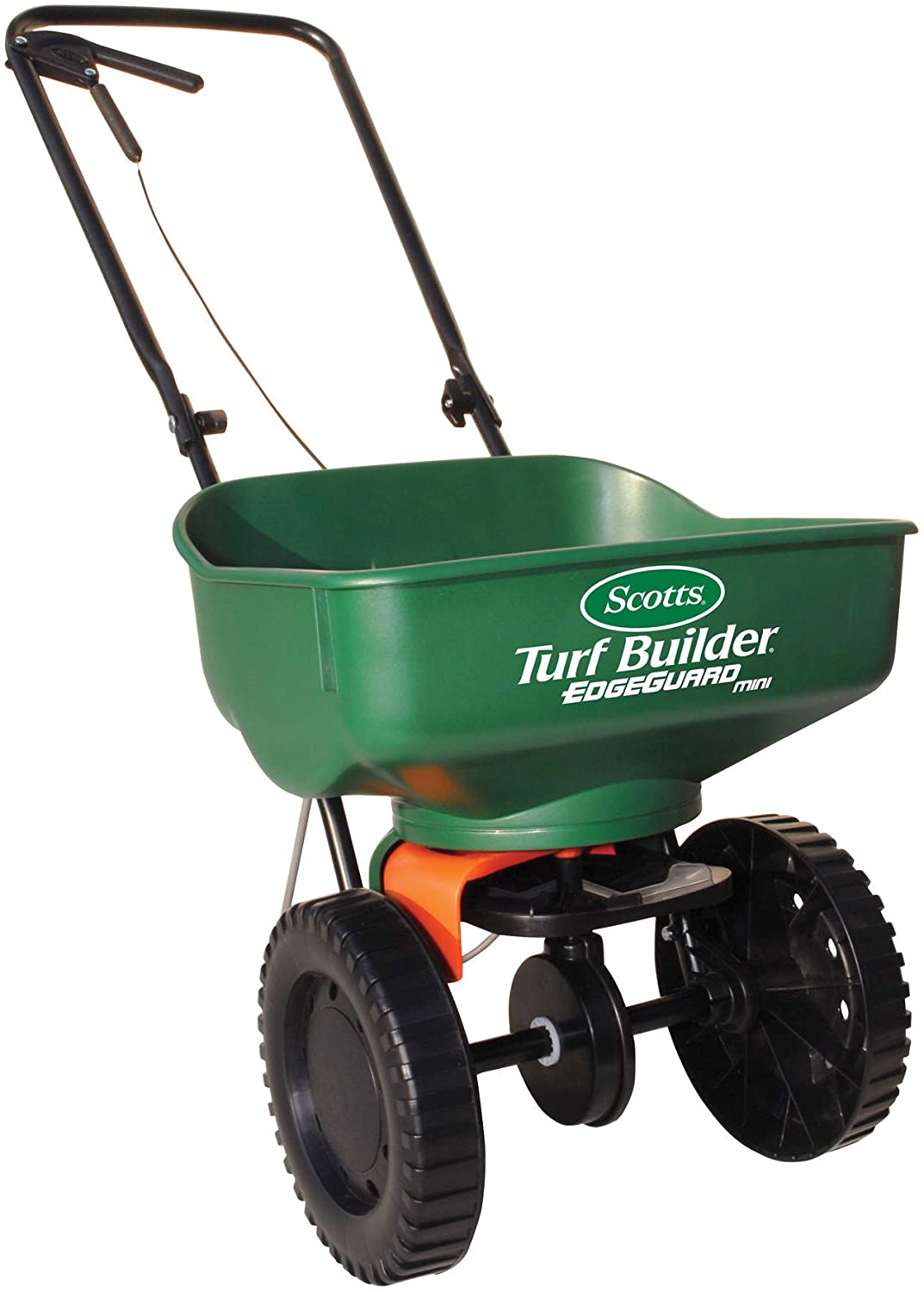
You don’t need to do it the traditional way when we have machines that can make your work easier. When you talk of spreading your grass seeds and fertilizer more effectively, Scotts turf builder mini broadcast spreaders are always there for you. It is equipped with exclusive EdgeGuard technology to keep products off your landscaping, driveways, and sidewalks.
With this product, you can be assured of the accurate spread of either fertilizer or grass seeds. It is also made with a control panel with rate settings that deliver even more accurate coverage.
Scotts 76121 turf builder EdgeGuard mini broadcast spreader also comes pre-calibrated and fully assembled with handles that you can fold for easier and compact storage. It is an ideal product for treating small areas.
The spreader comes with a walk-behind spreader that holds up to 5000 sq. ft of Scotts lawn product. When the latter is in action, it will block off the right side of the spreader pattern, preventing the product from spreading onto the non-lawn areas.
Features
- Made with Scotts exclusive edge guard technology
- Can hold up to 5000 sq. ft of Scotts lawns product
- Comes with a control panel precision rate settings facilitating accurate coverage
- Comes a readymade eliminating the assembling process
- Ideal for treating small areas
- The compact design makes it easier to store
- Designed to deliver superior results when used with Scott’s fertilizer and grass seed product
- Can be used for salting and best result use with Scotts ice melt
Pros
- Cheap and affordable
- Comes assembled
- Lightweight making it an easy to carry spreader
- Foldable for compact storage
- High quality and durable
- Ideal for more than single-use
Cons
- The door may get stuck when salting.
- Suitable for use on small pieces of lawn only
4. Amayrose Garden Hose Expandable Water Hose
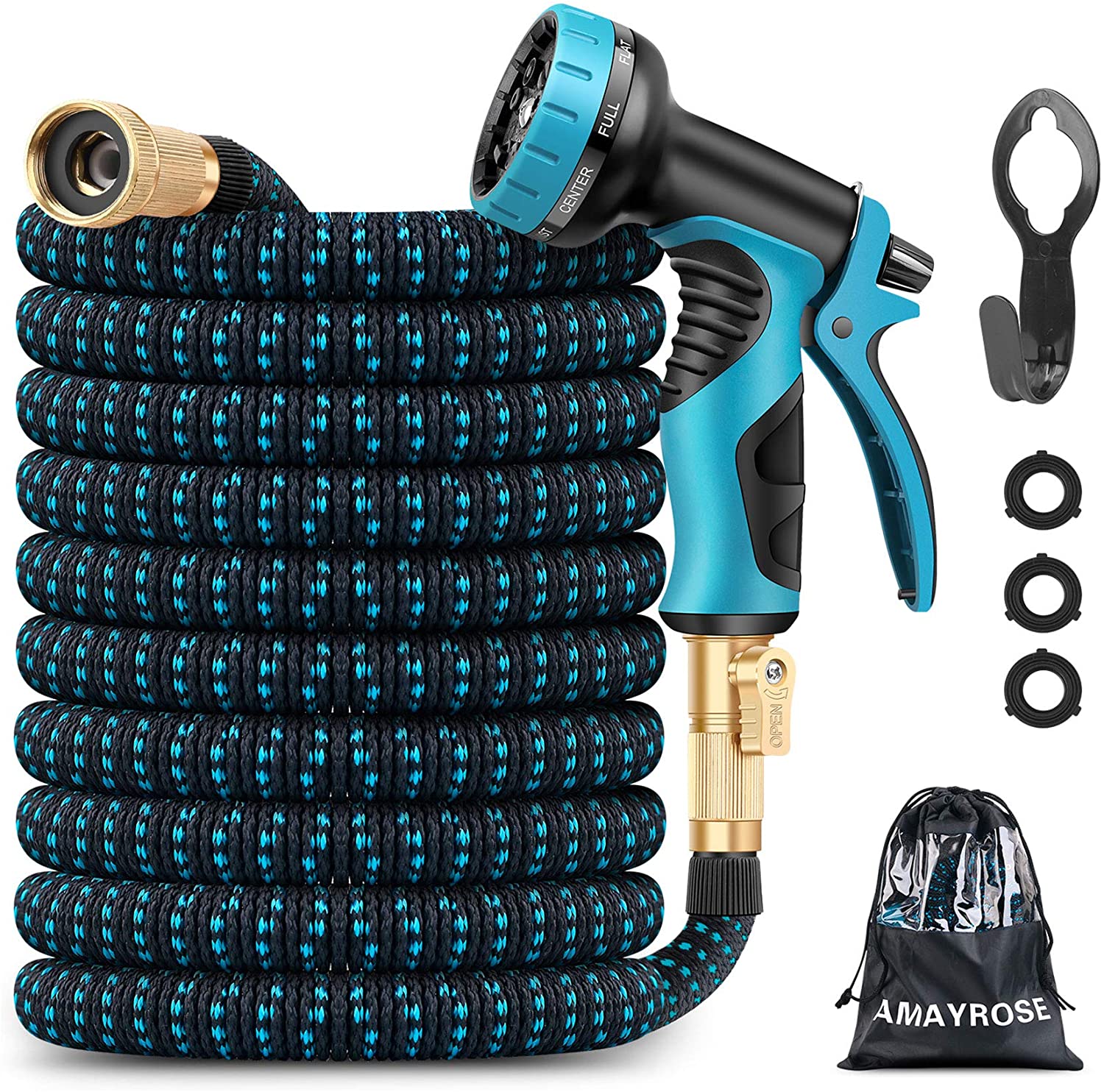
Amayrose garden hose expandable water hose is the hose that uses an ideal latex core and powerful 3750d polyester in preventing breakage and leakages. It can withstand a pressure of 3-12 bar temperature of 41-113 Fahrenheit, clearing all the doubts about the leakages, tear, or cracks.
The solid connector of ¾ inch brass connectors and layers of latex piping makes sure that the hose stretches well, solving the leakage problems of connectors made of plastic. Additionally, these connectors are made while observing American standard guidelines and rules.
This flexible hose comes with a good rotating non-resistant nozzle that is ever comfortable to use. With this hose, you can do multiple activities, including watering your lawn, cleaning your yard, washing your car, and also showering your pet if you do.
The shrink hose makes your gardening easier. Its original length is 9 feet, and you can expand it up to 3 times the original size with water pressure, and it retracts back when water is off.
Features
- Expandable garden hose
- Uses a great latex core and polyester fabric cover, preventing breakage and leakages
- Brass connectors ensure it Stretches out correctly, eliminating the problems of plastic connectors.
- It comes with a good rotating garden hose nozzle.
- Lightweight and portable
Pros
- Easy to use
- Lightweight making it portable
- Ability to maneuver
- Can stretch up to three times the original length
- Made with brass connectors that lasts long
Cons
- May does not last long.
5. Melnor 65074-AMZ XT Turbo
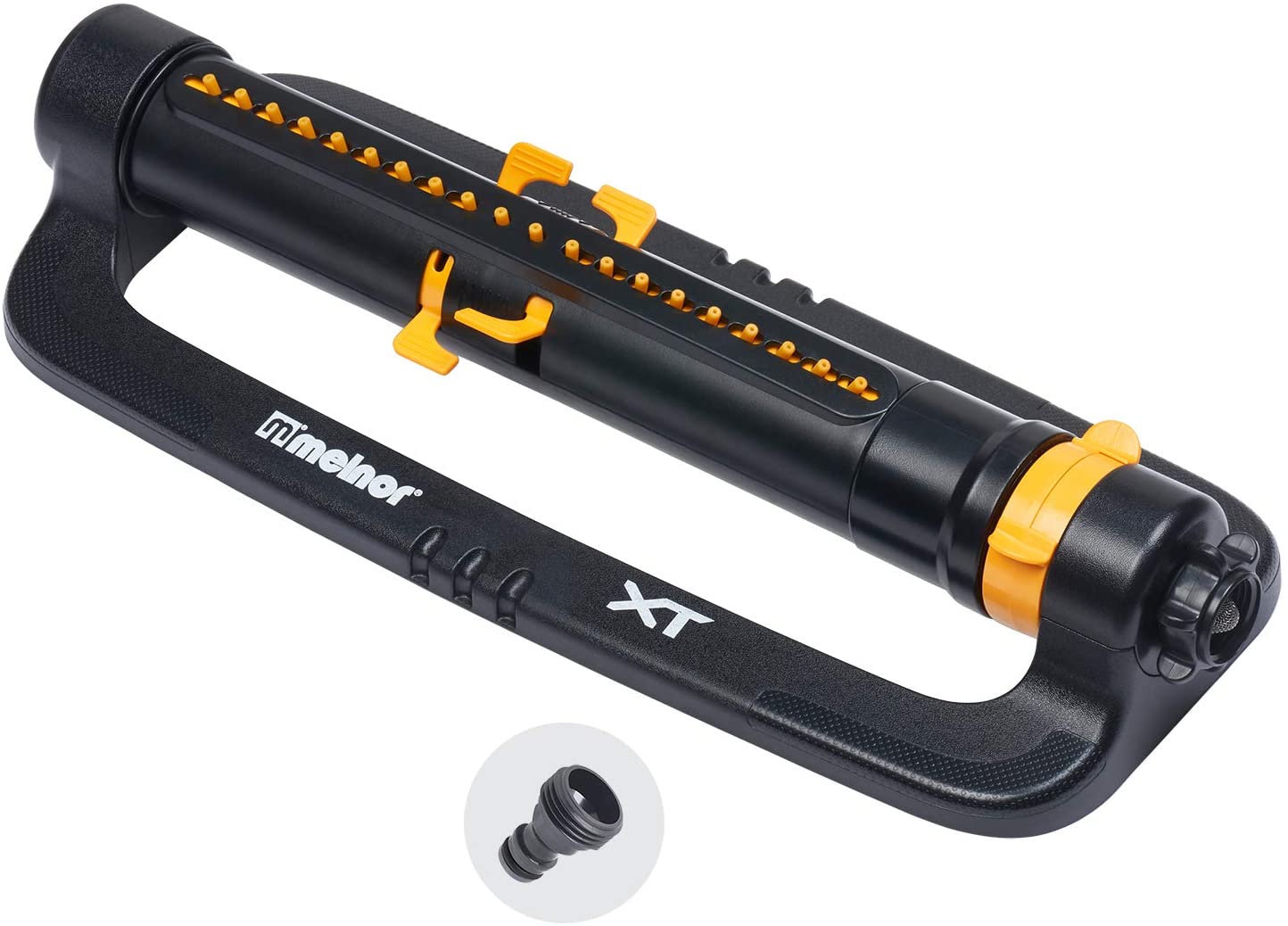
Regardless of the size of your yard, Melnor 65074-AMZ XT Turbo got you covered. It comes with a precision nozzle that can cover up to 4500 sq ft.
The easy adjustment that comes with this sprinkler allows you to set the width and the coverage space of the water spray to avoid sprinkling non-desires parts. Its motor is a dependable infinity turbo that offers smooth movements for even coverage that can’t puddle.
Melnor 65074-AMZ XT Turbo is designed to last longer for green grass and beautiful blooms season in season out. With the simple connection and disconnection, the Melnor 65074-AMZ XT Turbo watering tools are just a snap.
It comes with product adaptors that stay in place on the sprinkler, making it easy to attach to the hose anytime you need. If you are not using it, you can attach the sprinkler’s threaded end to any standard garden hose.
Features
- Range adjustment that changes the length of the pattern
- Prevents over or under watering with the Melnor water timers
- Twin touch width adjustment that allows independent side adjustment
- Tackles all watering chores
- Zoom control that changes the flow of the water to adjust the size of the coverage pattern
- Infinity turbo drive that provides the smooth operation for even watering and extended life
Pros
- Simple and easier to adjust
- Easy to move around
- Uncomplicated on and off power button
- Sturdy and stable
- Versatile
Cons
- Made with light plastic that may break easily
- Not heavy duty enough and not heavy enough
FAQs
Answer: Do the topdressing with quality topsoil or composite as a way of providing the best solution. Before topdressing, cut the lawn or the affected area, and you will find it easier to see the area at the topsoil level. Then go on and apply not more than half at a time and gently level it without completely sealing the grass.
Answer: We are confidently saying that it would best if you put down your grass seeds during the fall with several advantages.
In the early summer, the soil is still warm from months of the summer sun. With the combination of the warm soil, moderate day temperature, and cool evening, faster germination is assured, and the establishment of the grass seeds put down.
Answer: Yes, then the benefits of soaking your grass seeds are that they take a shorter time to germinate than seeds not soaked. It is recommended that you soak your seeds between 12 to 24 hours and not more than 48 hours if you are to prolong. After the desired time elapses, you are advised you can plant your seeds as directed.
Conclusion
Overseeding is possible without aeration, and you only need to pick the right grass seed and know the right time to overseed. It is important to make sure soil is prepared by doing different activities like applying fertilizer and providing the right and constant water amount.
Continue reading:

